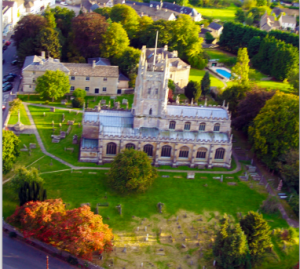 In the Domesday Book account of Fairford a priest is mentioned so it is quite likely there was a late Saxon church. For all we know there may be traces of a simple structure beneath the present building. The oldest visible features today are the small surviving sections of arches on the west sides of the central tower partly hidden behind the later buttressing. The ball flower decoration suggests a date in the 14th century. The tower itself was rebuilt early in the 15th century and this tower remained after wealthy wool merchant John Tame got permission from the Diocese of Worcester to demolish the rest of the church and rebuild it much larger. The additional buttressing was added to support an increase in the height of the tower. The new church was built around it which explains why our tower is in the middle of the church, not at one end as is customary.
In the Domesday Book account of Fairford a priest is mentioned so it is quite likely there was a late Saxon church. For all we know there may be traces of a simple structure beneath the present building. The oldest visible features today are the small surviving sections of arches on the west sides of the central tower partly hidden behind the later buttressing. The ball flower decoration suggests a date in the 14th century. The tower itself was rebuilt early in the 15th century and this tower remained after wealthy wool merchant John Tame got permission from the Diocese of Worcester to demolish the rest of the church and rebuild it much larger. The additional buttressing was added to support an increase in the height of the tower. The new church was built around it which explains why our tower is in the middle of the church, not at one end as is customary.
The new building is thought to have been carried out in the 1490’s and completed in 1497. It was in the Perpendicular style, a style that showed the mastery the craftsmen had over their materials. The slender elegant columns were strong enough to support the load on them and the larger arches allowed for large areas of glass. You only have to think of a typical Norman church with its chunky columns and tiny splayed windows to see how architecture had evolved over 400 years. The church has many similarities to St. Mary’s Oxford, which was substantially rebuilt in the late 15th century, and it’s thought that the Master Masons from Oxford were commissioned to build the new church in Fairford.
We don’t know whether the rebuild was carried out with a commission already prepared for the windows. It is likely to be the case given that they appear to have started work on glazing soon after the building was ready. John Tame died in 1500 so his son Edmund would have been in charge for the majority of the time the glass was being installed. By 1515 it was complete. Edmund also installed the screens in the chancel, alongside the fine tomb he built for his Father.
The church has remained largely unaltered and unspoilt since that time.
Updated 2nd December 2024
